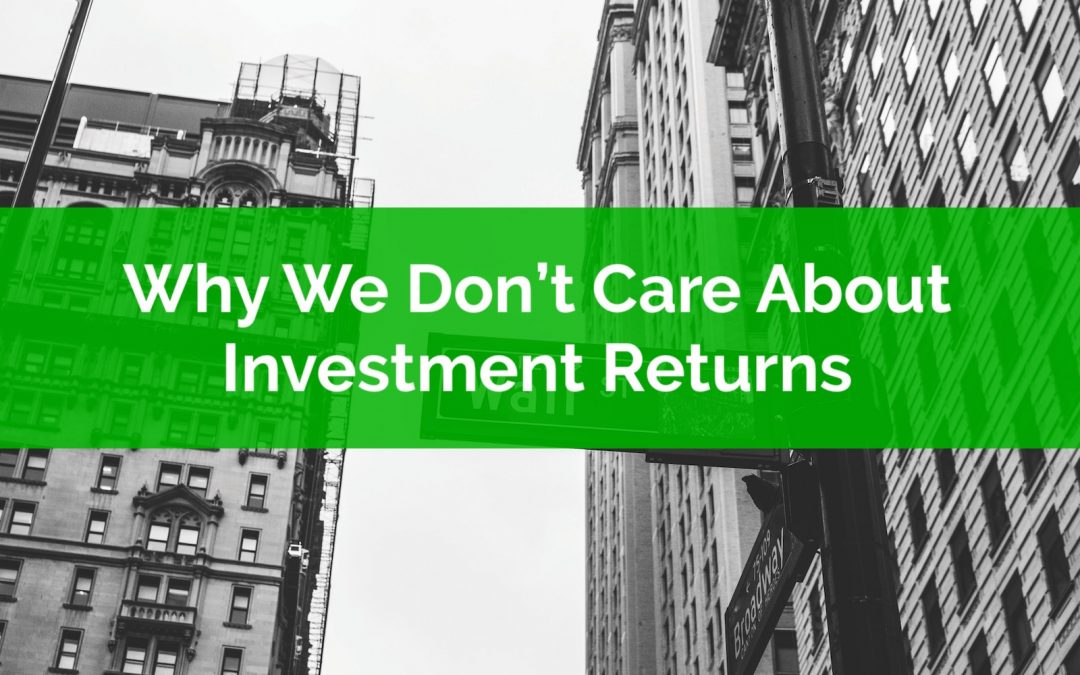
by Owen | Nov 30, 2020 | Behavioral Finance, Financial Planning, Investment Planning
This is the time of year when everyone starts talking about investment returns. It’s been a wild ride and just months ago it would have been difficult to imagine reaching positive investment growth year over year. With the incredible ups and downs of this year, investment returns are bound to be in the headlines over the next few months.
For some people, investment growth is an important metric. They care about time weighted returns, money weighted returns, and breaking down their year over year growth by geography, sector, and even individual investments.
We, however, don’t care about investment returns.
In fact, I couldn’t tell you what our year over year returns have been this year or in past years. The only way we’d know is because our discount broker likely tracks that for us. Otherwise it’s just not a personal finance metric we put much value in.
Of course, we do care about long-term returns, but we don’t care about year over year returns, and here’s why you shouldn’t either…

by Owen | Oct 26, 2020 | Behavioral Finance, Investment Planning, Retirement Planning
Retirement is full of risk. There is longevity risk, spending risk, health risk etc. But two of the largest risks in retirement are investment risk and inflation rate risk.
What if you could transfer some (or all) of that risk to someone else? That would make retirement that much more enjoyable, less to worry about and less to stress over. There would be more time to enjoy retirement itself rather than worry about retirement finances.
The problem with risk is that it’s hard to understand and hard to quantify. We’re pretty bad at assessing risk and probability. We might look back at the accumulation phase and think that we can manage the emotional impact of investment risk and inflation risk. After all, we’ve been managing those risks for 30-40+ years before retirement, why would that change in retirement?
The difference during the decumulation phase is that those risks are exacerbated by annual investment withdrawals. In retirement, these withdrawals, necessary to support retirement spending, multiply the effect of fluctuations in investment returns and inflation rates.
During the accumulation phase, investment contributions help reduce the impact of fluctuations (dollar cost averaging is a big benefit during accumulation). During the decumulation phase however, investment withdrawals multiply the impact of fluctuations.
As you’ll see below. The based on historical standards, the variation during the accumulation phase is nothing compared with the variation that’s possible during the decumulation phase.
So, transferring retirement risk to someone can become quite appealing when transitioning into retirement. It can help reduce that variation. Transferring even a small amount of retirement risk to someone can significantly improve peace of mind. Plus, it can help create a “floor” of retirement income that is virtually guaranteed.

by Owen | Oct 19, 2020 | Behavioral Finance, Financial Goals, Financial Planning, Investment Planning
Behavioral investment pitfalls can have a significant impact on investment returns for the average investor. The impact can be anywhere from 0.5% to 1.0%+ per year. But that’s the average impact on the average investor. The reality is that this impact will manifest differently for each investor and it could be years or even decades before an individual investor gets trapped by one of these behavioral pitfalls.
An average impact of 0.5% to 1.0% makes it sound like this happens every year. While this is true on average, it actually reflects many different experiences for many individual investors.
The truth is that some investors will experience no behavioral impact on their investment return for years and years before suddenly experiencing a negative effect. The AVERAGE impact of 0.5% to 1.0% means that in a given year some people experience no impact and others experience a small or large impact.
The problem is that this can lead investors into a false sense of security. It can make it seem like everything is going well until suddenly it’s not.
In this post we’ll provide three examples of how behavioral investment pitfalls can actually manifest in an investor’s portfolio and how they impact long-term investment returns.

by Owen | Oct 12, 2020 | Behavioral Finance, Financial Planning, Investment Planning
Compounding interest is a beautiful thing. It’s like magic. Give it enough time and compounding interest can turn even the smallest amount of money into millions.
Investing CAN be as easy as that, just set it and forget it. But when it comes to investing, we’re our own worst enemy.
Without guidance, rules, plans, checks and balances, we as individuals can cause some serious damage to our investment portfolios. We’re biased in many different ways and those biases create many behavioral investing pitfalls to watch out for.
There are many different behavioral investing pitfalls to be aware of, but some are more common than others (especially now that investing is even more easy and accessible). Some can be reduced with new investment options that automatically rebalance but there is still a risk.
Are you currently making one of these three behavioral investing mistakes?!?

by Owen | Sep 28, 2020 | Behavioral Finance, Financial Goals, Financial Planning, Retirement Planning, Saving Money
Financial Independence Retire Early (aka FIRE) is one of those big personal finance goals that has gotten a lot of attention recently. The idea of being financially independent, choosing when and if to work, is attractive for many people, especially when there is so much uncertainty in the world.
To be financially independent means that your investments (whether that be stocks, bonds, GICs, real estate etc) can provide enough income to cover annual expenses indefinitely. FIRE enthusiasts typically use the 4% rule as a guideline for how much income they can generate from their portfolio each year. The idea being that a person can draw 4% of their initial portfolio balance, adjusted for inflation each year, and have reasonably high chance of not running out of money after 30-years.
By using the 4% rule we can generate a rough target for FIRE. The basic idea is that you can take your annual expenses and multiply by 25 and that is your “FIRE number“. This is the amount needed in investments to safely retire early (although with low interest rates and low bond returns at the moment this rule is often thought to be too risky).
But despite it being a simple concept, reaching FIRE is a difficult task. It requires a high savings rate, low expenses, and lots of time.
FIRE is made easier with an above average income, which allows for a higher savings rate, but it is still a difficult task. Reaching FIRE means living well below your means for an extended period of time.
This combination of low spending, high savings, and a long time frame can lead to what’s known as “the boring middle”.
In this post we’ll briefly explain what FIRE is, why it’s so easy in the beginning, and why “the boring middle” could be a sign that there is an imbalance in the plan, one where the means may not justify the end.

by Owen | Sep 21, 2020 | Behavioral Finance, Get Out Of Debt, Pay Off Mortgage
In the world of personal finance, one of the best feelings is when you become debt free. Once you become debt free it’s like a weight has been lifted, you can breathe a sigh of relief, you’re free!
Creating a debt payoff plan is the fastest way to become debt free. It’s motivating. It’s provides a clear goal. It creates a clear payment plan to follow. But what makes a great debt payoff plan? There are a few important things that a great debt payoff plan should include.
Whether you’re paying off a bunch of credit card debt, or a big line of credit, or a student loan, or just want to see how long it will take to become mortgage free, a great debt payoff plan can make this happen.
What should be included in a great debt payoff plan? These six things are top of our list… (plus you’ll get a sneak peek at our new Debt Payoff Plan which is exclusively for clients to use when creating a financial plan with PlanEasy!)
Page 7 of 12«...56789...»






